| |
"History is written by the people who own the pens, the typewriters, the printing presses, the movie cameras, the TV cameras. 1968 in America, history was being written by people who are ignoring history." |
| |
Writer-director-cameraman Haskell Wexler |
|
"It's not what you look at that matters, it's what you see." |
|
Writer/philosopher Henry David Thoreau |
I would imagine that pretty much every film enthusiast can pull together a list of titles that were instrumental in shaping their love affair with cinema. There are the ones that had a serious impact on us in our childhood or teenage years, those that we found ourselves drawn back to again and again, and those special films we encountered by chance that helped widen our perception of what cinema could offer. If you are studying film production, either as a student or self-taught movie-maker, there are also the films that open your eyes to the myriad of possibilities that the medium has to offer as a tool for creative self-expression. These are the titles from which favourite film lists are born.
Such selections are inevitably personal choices, though the chances are that a good many of them will also have struck a similarly strong chord with others. There are no hard facts in the realms of film appreciation, but if enough opinions coincide then you will have a consensus, and it's from this that movies go on to achieve cult or classic status. But it's usually not the films on which we all seem to agree that are exciting to hear others enthuse about, but the ones we ourselves might never otherwise have seen. Such works will often provoke passionate outpourings, as those who have discovered a particular title seek to spread the good word. I am, of course, thinking retrospectively here, looking back to the days when reading or hearing about a film was one thing, but actually getting to see it was another, a time before the internet and even home video. Nowadays, if I wax lyrical to my fellow reviewers about a film, however obscure, there's a pretty good chance they can lay their hands on a copy by the end of the week, probably within the hour if it's available as a download or on a streaming service. Back then, you might only have one chance to see a particular title, a single screening at an independent cinema or on late night TV. The chance came and went in a single day and you missed it at your peril. If it did strike a chord then telling others about it would only frustrate them and you'd have to survive on your memories of that screening until the opportunity for a second viewing might randomly present itself.
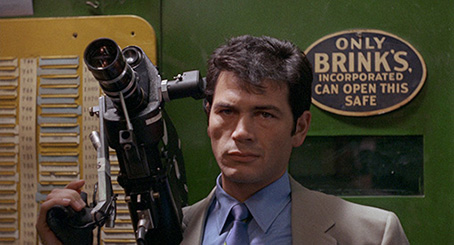
I can't remember exactly where and when I first saw Haskell Wexler's 1968 Medium Cool, but I distinctly remember the impact it had. I do know that I was in my third year of film school, by when I'd made camerawork my specialisation. Medium Cool is a film about a cameraman directed by a cameraman. A great cameraman, as it happens, one with a social conscience and the sort of left-leaning political beliefs that by this point in my life I was starting to embrace. And Medium Cool looked like no other film I saw during that period. For the first time I really began to appreciate how a narrow depth of field could be employed to isolate a character in frame, and how the use of extreme wide-angle lenses could bring an extra dynamism to energetically mobile handheld shots. This was a film that helped to redefine what I was learning about my chosen craft, but I remember even then appreciating that the film was so much more than a technical exercise. The problem was that the moment to see it had now come and gone, and no-one else on my course had managed to catch it, so I couldn't even get into a debate about it with others. It was to be a another fifteen years until I was able to see it again.
Medium Cool begins with a sobering comment on emotional and moral detachment that can infect professional news journalism, as TV cameraman John Cassellis (Robert Forster) and his sound man Gus (Peter Bonerz) arrive at the scene of a fatal car accident and begin silently shooting. Only as they head back to their car does it occur to them to call for an ambulance. It's a scene that we'll later be prompted to recall, the first example of a number of cyclic elements within the film.
The imagery then switches from 35mm observational realism to 16mm documentary footage of real-life TV news men and women engaged in heated discussion about the nature and responsibilities of their job, revealing some specifics about what John Cassellis does for a living through the words of his real-life counterparts, and shot in the way John himself might have filmed it. It's one of many tonal shifts that occur throughout the film that on paper should disrupt the narrative flow and make us distractingly aware of the technique, but they never do. So beautifully do the scenes transition into each other (sometimes invisibly and elsewhere with purposeful aggression – full marks to editorial consultant Paul Golding and editor Verna Fields here) that the film becomes the epitome of the freedom of expression for which the 60s are still celebrated, an experimentation with form and structure that vividly captures the mood and creative rebellion of its time, in its structure and its artistry as well as its content.

The documentary realism continues into the scene that follows as John and Gus cover a training exercise in which the Illinois National Guard dry-run a somewhat excessive response to planned protests against American involvement in the war in Vietnam. It's a sequence that consciously invites multiple readings. On the surface it's there to show John and Gus on assignment, yet as we watch images shot by Wexler of John filming real-life preparations for the suppression of protest in the land of the free, we are initially unaware that the scenario being cheerfully play-acted here will unfold for real in the film's now-famous climax. As a final shout of "Let's get the guys with the cameras!" sees the fourth wall kicked asunder as the soldiers mob John and then pile onto Wexler, we are offered a small and comparatively 'safe' foretaste of what protesting students will face later in the film, when the men with uniforms and nightsticks will turn on them. It's a moment that will also resonate later when a revelation about what some of his footage is being used for prompts John to angrily proclaim, "it's a wonder more cameras haven't been smashed." This layering is evident in pretty much every scene in the film, a good deal of which only becomes clear in retrospect or on subsequent viewings.
Unfolding in tandem with John's story is that of young Chicago Appalachian boy Harold (winningly played by non-professional Harold Blankenship) and his mother Eileen (Verna Bloom), who are struggling to get by in one of the poorest districts of the city since the death or departure of Harold's father (the truth about his absence is never firmly established). The two strands collide when John spies Harold kneeling down next to his car, and believing that the boy is stealing his hubcaps he gives energetic chase. In the process of fleeing, Harold drops a basket containing a racing pigeon that is his only real passion, and when John returns the animal to its labelled address, he meets and takes a gradual liking to Eileen, and over time starts to become a surrogate father to Harold.
John has effectively built a wall around him that enables him to emotionally distance himself from his subjects in a manner that leaves no room for empathy or compassion. It's all about the story, the five minutes of film that will provide the news programme he shoots for with enough filler to take it to the next commercial break. When challenged on this by his current girlfriend Ruth (Marianna Hill), he becomes defensive and deflective, and when he walks into a nest of potentially interesting stories whilst visiting newsworthy black cab driver Frank Baker (Sid McCoy), he becomes aggressively resistant to the pitches of Frank's more militant friends because they all deviate from his original game plan. It's the sequence in which Wexler most directly confronts the news media for the vacuity of its coverage, and ultimately the audience through a beautifully written (by Wexler) monologue delivered straight to camera that concludes with an incisive socio-political statement made purely through the juxtaposition of one shot with another. That, my friends, is the power of editing.
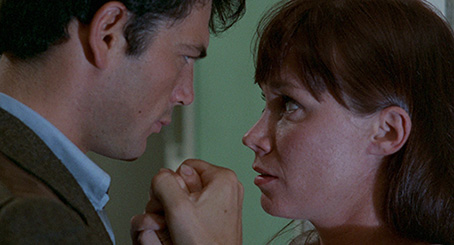
It's through his developing relationship with Eileen that the process of John's (re-) humanisation begins. But there are no big Hollywood-style revelatory changes here, just baby steps that may either be his salvation or too little too late. Yet even in some of their most tender moments, John seems defined by what he does – as he and Eileen become captivated by a TV transmission of the era-defining speech by Dr. Martin Luther King following his assassination, Eileen draws spiritual inspiration from his words, while John states with passion, "Jesus, I love to shoot film," then launches into a cynical deconstruction of how media coverage of major events plays out to a pre-prepared script. It comes as no surprise that even Wexler himself has suggested there is a good deal of himself in John.
Of course, the scene for which the film quickly became famous is the climactic coverage of the protest in Lincoln Park staged during the week of the 1968 Democratic National Convention, a sequence whose collision of staged drama and documentary realism is almost without parallel in cinema history. As Elaine wanders through the park against a background of peaceful protest and the increasingly intimidating and insanely disproportionate police and National Guard presence, there's a very real sense that this is a powder keg of confrontation just waiting to explode. When it does, the impact is startling, as fact melds so completely with fiction that all divisional aesthetic barriers are effectively blown away. As the police attack the demonstrators and people are left battered and bleeding, Wexler and fellow camera operator Mike Margulies are in its epicentre, capturing striking and intermittently frightening vérité documentary footage in pristine 35mm, a format we tend to associate more with staged dramatic features, while Verna Bloom somehow manages to stay in character throughout, making her way through the crowds and the riot itself as Eileen in search of her absent son.
Since the film was first screened, Wexler has admitted that the film's most famous line – the off-camera shout of "Look out Haskell, it's real!" as a tear-gas canister is fired towards the camera – was not the spontaneous cry that it was once believed to be and was added by him in post-production to put the words that went through his head at that moment into the film. It matters not, and in retrospect could almost be a message aimed at an audience raised on digitally processed movies whose picture of reality is endlessly manipulatable and can no longer be taken at face value. Here it is all real, and that knowledge is what makes some the imagery in this sequence so disturbing – as Eileen walks away from Lincoln Park and past seemingly endless lines of military vehicles and armed National Guardsmen, Downtown Chicago takes on the look and feel of a foreign land under military occupation.
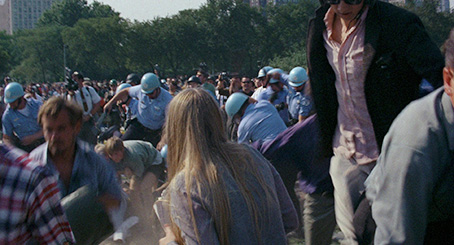
The inventive economy of some of the filmmaking may well require a modern international audience to do a little reading up to appreciate the full implication of a couple of scenes. A key example is the assassination of Bobby Kennedy, which is not relayed through an expositional news broadcast but though a circular shot of the kitchen in which his murder took place as his final speech plays on the radio in the background, which cuts away just as the delegates burst into the room. In the very next scene, John and Gus are being driven past TV camera gantries and are asked by their driver, "You guys here to cover the funeral?" – Wexler provides the jigsaw pieces but leaves it to us to snap them together. The openly allegorical elements also encourage you to read deeper meaning into even more seemingly straightforward scenes. It struck me immediately that Harold's racing pigeon – an animal that is kept caged and when freed has been conditioned to follow a strictly pre-determined path – was a reflection of aspects of Harold's home life and the restrictive nature of his future prospects. This really hits home at the gorgeously shot pigeon meet, when thousands of birds are simultaneously released and soar into the sky in a unified expression of liberation before embarking on their individual pre-programmed journeys, which widens the metaphor to include a sizeable portion of the population at large. Listening to Wexler talk about the film I've become increasingly convinced that this was all intentional.
Medium Cool is a film about which books could be written, with each scene deserving of its own weighty chapter. Coming back to the film after a gap of several years I was worried that I might have mythologised it in my memory, its qualities inflamed by the impact it had on my younger self. But watching it again was almost as thrilling and possibly even more revelatory than seeing it for the first time. All these years later, with thousands more film viewings under my belt, what astonishes me most is how fresh and original and unique it still feels, and how wide and precision-targeted is the reach of its socio-political subtext. So focussed was I as a young trainee camera operator on the look of the film that I failed to appreciate the inventiveness and ironic wit of its use of music and the creativity and potency of its editing and soundtrack. The naturalism of the performances makes it hard in places to be sure which of the cast are professional actors – at one point actor Sid McCoy (as cab driver Frank Baker) is grilled by a real-life police detective and both feel like the real deal, one of many sequences in which actors and non-professionals invisibly intermingle, adding a further layer to the film's complex blurring of the line between reality and fiction, or more specifically what we perceive as either.
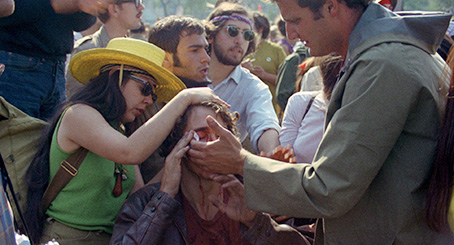
There is so much in this astonishing film to absorb that it lends itself perfectly to the home viewing age, when we are able to watch it several times in succession and unpick and appreciate the multiple messages that have been expertly weaved into its sophisticated and artistically thrilling surface tapestry, then go back and completely re-interpret what we've seen. It's now easier than ever for me to understand why Medium Cool so affected me as a young and eager student of cinema. It flies the flag for 60s free-spirited and adventurous socio-political filmmaking, and in its melding of truth and fiction – in a manner that prompts us to rethink how we view any subsequent film material – it is virtually without peer. It's still one of my all-time favourite films, and one that in my humble view fully deserves the exalted label of masterpiece.
Although it was filmed largely on 35mm, much of Medium Cool was shot vérité style with naturalistic or in some cases available light on what I'm assuming was high speed stock (or at least what constituted high speed back in 1968), and as a result the image doesn't pop from the screen in the manner of some higher budget studio films of the period, but then I doubt it was ever intended to. Naturalism is the order of the day here, and this is handsomely captured by the 1080p image on this disc, which was sourced from a 4K digital film transfer approved by Wexler. The level of detail far exceeds that of the previous Paramount DVD, the contrast is impeccably balanced and the colour palette so pleasingly rendered that it makes me yearn for the days when the colour in films was a damned sight closer to how it looks in real life than it seems to be in the digitally tweaked movies of today. The flashback sequences in particular look terrific and the effectiveness of the riot footage stems in no small part to the fact that it has a feature film rather than a newsreel aesthetic. The image is free of dust spots and damage and displays no movement in frame. This is how the film was always meant to look.
The linear PCM 24-bit mono 2.0 soundtrack is also in fine shape with no damage or obvious underlying hiss or crackle. There are some minor range restrictions, but the music sounds fine.
Optional subtitles for the deaf and hearing impaired are available.
Commentary
Recorded in Edinburgh in 2001 following a screening of the film, and originally included on Paramount's US DVD release of the same year, this commentary features writer-director Haskell Wexler, editorial consultant Paul Golding and actor Marianna Hill, and it's an absolute belter. There's a ton of information provided on the film and its production here, largely by Wexler and Golding, with occasional contributions from Hill, who I began to suspect was not there for the whole recording (at one point Wexler refers to her by her full name, an odd thing to do if she was sitting beside him). To start listing all of the areas covered here would fill a sizeable magazine article, but a few personal favourites include Wexler's original desire to have John Cassavetes play the lead role (which almost happened but was scuppered by the old film industry favourite of scheduling conflicts); the in-film references to the work of Jean-Luc Godard; the material that was shot but that didn't make the final edit (including footage of a young Jesse Jackson, who is glimpsed briefly here); the background information on some of the non-professional actors; the socio-political elements and how they tied up with Wexler's own beliefs; the technical details of how some sequences were filmed; the reasons for the film initially being stung with a paralysing X certificate, and so on. There's so, so much more here, almost all of it gold for fans of the film, with even the anecdotal elements adding to your appreciation of the effort and passion that went into its making. I was particularly pleased to have some background info on the shooting of the climactic protest riot and the scene in which John and Gus pay a visit to cab driver Frank Baker and are hassled by his more militant friends. Superb.
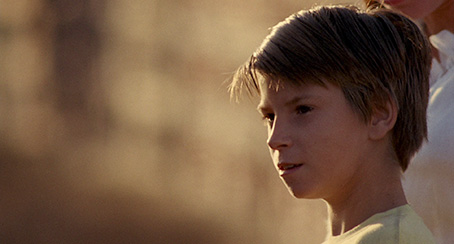
Look Out Haskell, It's Real! (53:18)
A collection of extended excerpts from Paul Cronen's 2001 documentary, Look Out Haskell, It's Real: The Making of Medium Cool, which was only seven minutes longer than this in its entirety – I guess the key word here is 'extended', suggesting the inclusion of material not used in the final cut of that documentary. Inevitably there is some crossover with the commentary track, but the scope is wider here and the participants more varied, including as they do historians, Chicago activists, former protesters and even National Guardsmen. There's plenty of material on the filming of the riot, but also coverage of footage that was shot and not used in the film, some of which is included here. Another fine inclusion.
Sooner or Later (16:01)
Excerpts from a documentary directed by Paul Cronin that you'll find no trace of on IMDb, which revisits Harold Blankenship 40 years after his role as Harold in Medium Cool. I'm pretty sure I'd never had recognised him had I not been told who he was in advance – sporting long hair and beard, the older Blankenship has retreated into the woods and raised a family there, and almost gives the impression of having completely dropped out of society. He looks back at his youth and regrets his lack of schooling, though the sometimes long pauses suggest he's not quite as comfortable being on camera as he once was.
Haskell and the Cameras (10:15)
Filmed in his workshop by Paul Cronin in January 2013, Wexler shows us the equipment that he used to shoot the film and the Éclair camera that Robert Forster carried as Paul. Great stuff for us camera tech-heads, it includes a look at the special 1000ft magazine that Wexler had the engineers at Paramount construct especially for him to enable him to shoot longer without changing magazines.
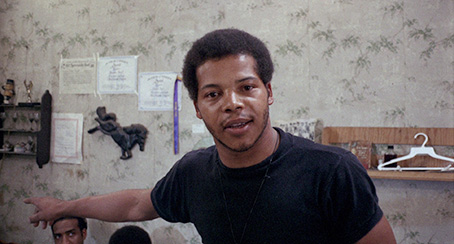
Also included is the usual Masters of Cinema Booklet, which this time around contains only one article, but it's an absolute doozy. In December 1968, a report on the violent confrontations between police and demonstrators during the week of the Democratic National Convention was submitted by Daniel Walker, director of the Chicago Study Team, to the National Commission on the Causes and Prevention of Violence. It was compiled from over 20,000 pages of statements from 3,437 eyewitnesses and participants, 180 hours of film, and over 12,000 still photographs. Reproduced here in its entirety is the summary that prefaced that doubtless weighty report, and if you were shocked by what unfolds in the climax of the film then some of the observations here will make your hair stand on end. What makes it so persuasive is Walker's clear attempt to take a balanced viewpoint, highlighting when he believed the demonstrators were provocative and acknowledging the need to respond to a tangible threat, but the evidence paints a clear and frightening picture of violence on the part of a significant number of Chicago policeman that was excessive, indiscriminate and often maliciously and even gleefully dispensed. An essential read. Also on board are the main film credits, notes on viewing and some quality stills.
One of my all-time favourite films getting a top-notch HD transfer on a well-featured Blu-ray. Yes it's available on Criterion Blu-ray in the US, which does slightly better on the extra features, but comparisons have suggested that the transfer on the Masters of Cinema disc is every bit the equal of the Criterion one, and you won't need a region-A enabled player to view it. Great film, great disc, love it. Highly recommended.
|